From Perriand to Prouvé, François Laffanour sets the stage for a masterclass in modernism

Ardent admirers and collectors of Jean Prouvé, Charlotte Perriand, Serge Mouille and Le Corbusier will already know that Laffanour Galerie Downtown Paris stands out for its superior selection of 20th-century furniture and decorative objects. At the annual Biennale des Antiquaires – freshly branded La Biennale Paris – the Left Bank gallery once again staged an immersive and inspired arrangement of its collection, this time with a few noteworthy additions.
With faux structural columns in high-gloss bluish grey placed throughout the booth, visitors immediately sense the shift from the Beaux-Arts expanse of the Grand Palais to a modern architectural style and scale. The space, despite its brief six-day run, feels permanent. ‘What I love with the columns is the reference to Le Corbusier but at the same time, also a reference to the classicism of Greece, which he was actually referencing, too,’ François Laffanour told us.
The dark palette continues along the left wall where a Perriand bookcase is complemented by her ‘Forme Libre’ table and armchairs, the latter newly reupholstered in graphic cowhide. Laffanour says this ensemble suggests ‘great rigour and elegance’, adding that ‘here, you see the most beautiful of Perriand’s works; there’s obvious simplicity as well as luxury even though the materials that are not at all luxurious’.
To the right, a grouping of chairs and a sofa by Pierre Jeanneret appear in the same cowhide, with further punch provided by Prouvé’s ‘Bahut’ console panelled in red. Hanging directly above is a unique Le Corbusier tapestry filled with expressive shapes including a geometric plot of primary colours, decoupage-style bodies, a pair of footprints and a meandering rope. Titled ‘Trace des pas dans la nuit’ (‘Trace of footprints in the night’), it is listed by the Fondation Le Corbusier but was never commercialised.
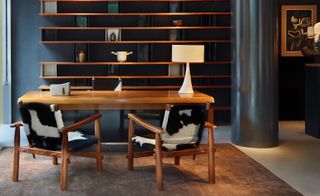
Installation view of Laffanour Galerie Downtown Paris
Workmanship aside, the large format and dynamic composition make it as visually impactful as anything in the booth. But just a little further on, a bookcase from Prouvé is, in its own way, equally remarkable. Commissioned in 1951 to furnish the Villa Dollander in southeastern France, it features three green steel beams staggered with shelves, the lowest one swooping outward to function as a desk. Laffanour notes a ‘poetry’ to the design, pointing out how Prouvé has ‘humanised’ an otherwise utilitarian form.
The effect of an enlarged Le Corbusier print along one back wall and a floor-to-ceiling mirror on the other seemingly expands the space beyond its 92 sq m and visitors may wish they could, indeed, proceed further. Instead, they might find themselves lingering over a rare polychrome wood sculpture, Ozon Opus I, conceived by the architect in 1947 with the help of Joseph Savina, a cabinetmaker from Brittany.
The assemblage seems dream-like and widely open to interpretation, yet there’s no denying a similarity between the rising blue mass and his distinctive ship-inspired chimney of the Cité Radieuse in Marseille. And even though Le Corbusier himself was not a sculptor, the piece, according to Laffanour, holds significance within his canon. ‘I consider it a very important piece; what you see is so original – a little surrealist, a little cubist. It’s truly extraordinary. I was eager to show this because as a counterpoint to the furniture that is well-balanced, this presents a notion that is sculptural yet also mental,’ he explains, noting how it brings dimension to the abstracted, cubist aspects that Le Corbusier had pursued in his earlier purist paintings with Amédée Ozenfant.
This version, with its name referring to the Pyrenean village where Le Corbusier lived for a short time in 1940, is one of three and belonged to Savina himself. Apparently, the architect intended to make a larger version, no doubt amplifying the strangeness. Yet at this size, the sculpture feels contained and satisfying – an impression that could just as easily apply to Galerie Downtown’s booth, as well.
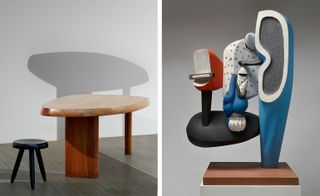
From left, ‘Forme Libre’ table and stool, by Charlotte Perriand; and ‘Ozon Opus I’, 1947, by Le Corbusier.
INFORMATION
For more information, visit the Laffanour Galerie Downtown Paris website
ADDRESS
Laffanour Galerie Downtown Paris
18 Rue de Seine
75006 Paris
TELEPHONE
Wallpaper* Newsletter
Receive our daily digest of inspiration, escapism and design stories from around the world direct to your inbox.
33.1 46 33 82 41
-
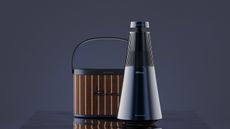 Tech Editor, Jonathan Bell, selects six new and notable Bluetooth speaker designs, big, small and illuminating
Tech Editor, Jonathan Bell, selects six new and notable Bluetooth speaker designs, big, small and illuminatingThese six wireless speakers signal new creative partnerships and innovative tech approaches in a variety of scales and styles
By Jonathan Bell Published
-
 As London’s V&A spotlights Mughal-era design, Santi Jewels tells of its enduring relevance
As London’s V&A spotlights Mughal-era design, Santi Jewels tells of its enduring relevance‘The Great Mughals: Art, Architecture and Opulence’ is about to open at London’s V&A. Here, Mughal jewellery expert and Santi Jewels founder Krishna Choudhary tells us of the influence the dynasty holds today
By Hannah Silver Published
-
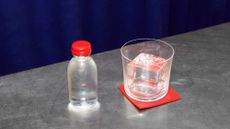 London bar Bauhaus Warehaus is a factory by day, drinking den by night
London bar Bauhaus Warehaus is a factory by day, drinking den by nightMixologist of the moment Remy Savage shakes up the world of cocktail-making with a hardworking sibling to A Bar with Shapes for a Name, his Bauhaus-inspired bar enterprise in east London
By Neil Ridley Published
-
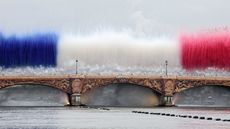 Olympics opening ceremony: a little Gaga, a lot of spectacle, and universal uplift
Olympics opening ceremony: a little Gaga, a lot of spectacle, and universal upliftHow Paris 2024’s Olympics opening ceremony set spirits – and much else – soaring, embracing the Seine, the streets and the skies. Craig McLean reports
By Craig McLean Published
-
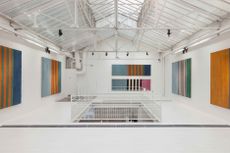 Paris Design Week 2023: the highlights
Paris Design Week 2023: the highlightsYour essential guide to Paris Design Week 2023, from Maison & Objet to Paris Déco Off, and the best things to see in town as part of Maison & Objet City
By Rosa Bertoli Published
-
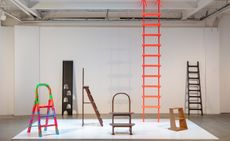 Step by step: Virgil Abloh, Jaime Hayon and more rethink the ladder at Galerie Kreo, Paris
Step by step: Virgil Abloh, Jaime Hayon and more rethink the ladder at Galerie Kreo, ParisA new exhibition at Galerie Kreo, ‘Step By Step’, invites more than 20 designers to rethink the ladder’s classic design
By Hannah Silver Last updated
-
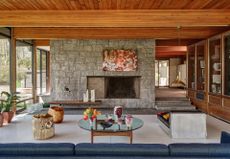 ‘At The Luss House’ celebrates the architecture of Gerald Luss
‘At The Luss House’ celebrates the architecture of Gerald LussAn immersive exhibition, ‘At The Luss House’, celebrates the work of architect Gerald Luss with a display of contemporary art and design curated by Blum & Poe, Mendes Wood DM, and Object & Thing
By Pei-Ru Keh Last updated
-
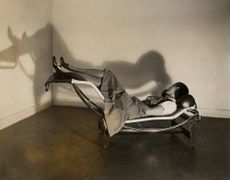 Charlotte Perriand’s life and work explored at London’s Design Museum
Charlotte Perriand’s life and work explored at London’s Design MuseumLondon’s Design Museum presents ‘Charlotte Perriand: The Modern Life’, an exhibition turned the spotlight on one of the most iconic creators of the 20th century
By Rosa Bertoli Last updated
-
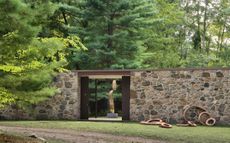 Art and design combine at Eliot Noyes' modernist residence
Art and design combine at Eliot Noyes' modernist residenceBlum & Poe, Mendes Wood DM and art and design fair Object & Thing come together to present a new type of contemporary display at the Noyes house
By Pei-Ru Keh Last updated
-
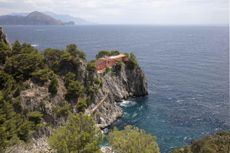 Gagosian brings a taste of Casa Malaparte to London
Gagosian brings a taste of Casa Malaparte to LondonLondon's Gagosian Gallery presents a collection of furniture reproductions from Casa Malaparte, Curzio Malaparte's legendary villa perched atop a promontory on the island of Capri
By Ali Morris Last updated
-
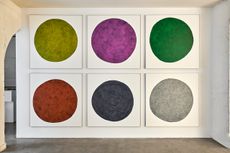 Virtually experience the shapes and colours of Pierre Charpin
Virtually experience the shapes and colours of Pierre CharpinTake a digital 3D tour of Pierre Charpin’s show ‘Similitude(s)’ at Paris’ Galerie Kreo that explores colour and geometry
By Ali Morris Last updated